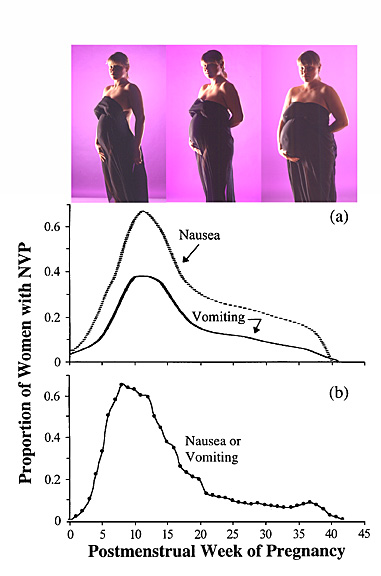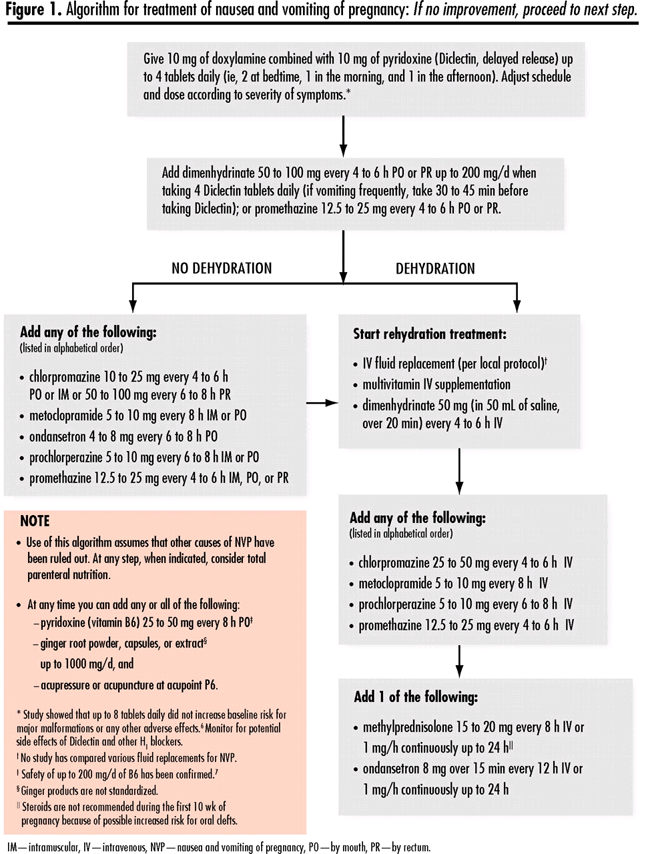When vomiting start in pregnancy
Morning Sickness: Nausea and Vomiting of Pregnancy
-
Nausea and vomiting of pregnancy is a common condition. It can occur any time during the day, even though it’s often called “morning sickness.” Nausea and vomiting of pregnancy usually doesn’t harm the fetus, but it can affect your life, including your ability to work or go about your normal everyday activities. There are safe treatment options that can make you feel better and keep your symptoms from getting worse.
-
Nausea and vomiting of pregnancy usually starts before 9 weeks of pregnancy. For most women, it goes away by 14 weeks of pregnancy. For some women, it lasts for several weeks or months. For a few women, it lasts throughout the pregnancy.
-
Some women feel nauseated for a short time each day and might vomit once or twice.
In more severe cases, nausea lasts several hours each day and vomiting occurs more frequently.
-
You should talk with your obstetrician-gynecologist (ob-gyn) or other obstetric care provider if nausea and vomiting of pregnancy affects your life and causes you concern.
-
Hyperemesis gravidarum is the term for the most severe form of nausea and vomiting of pregnancy. Hyperemesis gravidarum occurs in up to 3 percent of pregnancies.
-
This condition may be diagnosed when a woman has lost 5 percent of her prepregnancy weight and has other problems related to dehydration, or loss of body fluids (see below). Women with hyperemesis gravidarum need treatment, sometimes in a hospital, to stop the vomiting and restore body fluids.

-
Nausea and vomiting can cause you to lose fluids. If fluids are not replaced, it can lead to dehydration. You should call your ob-gyn or other obstetric care provider if you have the following signs and symptoms of dehydration:
-
You have a small amount of urine that is dark in color.
-
You are unable to urinate.
-
You cannot keep down liquids.
-
You are dizzy or faint when standing up.
-
You have a racing or pounding heartbeat.
-
-
Any of the following can increase the risk of severe nausea and vomiting of pregnancy:
-
Being pregnant with more than one fetus (multiple pregnancy)
-
A previous pregnancy with either mild or severe nausea and vomiting
-
Your mother or sister had severe nausea and vomiting of pregnancy
-
A history of motion sickness or migraines
-
Being pregnant with a female fetus
-
-
Yes, some medical conditions can cause nausea and vomiting during pregnancy.
 These conditions include:
These conditions include:Your ob-gyn or other obstetric care provider might suspect that you have one of these conditions if you have signs or symptoms that usually do not occur with nausea and vomiting of pregnancy. Some of these signs and symptoms include:
-
Nausea and vomiting that occurs for the first time after 9 weeks of pregnancy
-
Abdominal pain or tenderness
-
Fever
-
Headache
-
Enlarged thyroid gland (swelling in the front of the neck)
-
-
This condition usually does not harm your health or your fetus’s health. It also does not mean that your fetus is sick.
-
Nausea and vomiting can become more of a problem if you cannot keep down food or fluids and begin to lose weight.
 When this happens, it sometimes can affect the fetus’s weight at birth.
When this happens, it sometimes can affect the fetus’s weight at birth. -
Weight loss can lead to problems with your thyroid, liver, and fluid balance. Because hyperemesis gravidarum is difficult to treat and can cause health problems, experts recommend early treatment so that it does not become severe.
-
Changes to your diet and lifestyle might help you feel better. These change can include:
-
Yes, take a prenatal vitamin. Studies show that taking a vitamin supplement before and during pregnancy reduces the risk of having severe nausea and vomiting of pregnancy.
-
-
Eat dry toast or crackers in the morning before you get out of bed to avoid moving around on an empty stomach.

-
Eat five or six “mini meals” a day to ensure that your stomach is never empty.
-
Eat frequent bites of foods like nuts, fruits, or crackers.
-
-
Try bland foods. The BRATT diet (bananas, rice, applesauce, toast, and tea) is low in fat and easy to digest. If these foods don’t appeal to you, try others. The goal is to find foods that you can eat and that stay down.
-
Yes, try adding protein to each meal. Good nonmeat sources of protein include:
-
Dairy foods, such as milk, ice cream, and yogurt
-
Nuts and seeds, including butters like almond butter and peanut butter
-
Protein powders and shakes
-
-
Ginger can help settle your stomach.
 You can try:
You can try: -
Yes, your body needs more water during pregnancy. Drink throughout the day, not just when you are thirsty. Aim for 8 to 12 cups of water a day during pregnancy.
Not drinking fluids can lead to dehydration, which can make nausea worse. If a bad taste in your mouth makes it hard to drink water, chew gum or eat hard candy.
-
Foods or odors that might never have bothered you before might now trigger nausea. Do your best to stay away from them. Use a fan when cooking. Have someone else empty the trash.
-
Frequent vomiting can cause some of your tooth enamel to wear away, due to the acid in your stomach. Rinse your mouth with a teaspoon of baking soda dissolved in a cup of water to help neutralize the acid and protect your teeth.

-
If diet and lifestyle changes don’t help, or if you have severe nausea and vomiting of pregnancy, you might need medical treatment. Your ob-gyn or other obstetric care provider will first want to know whether your symptoms are due to nausea and vomiting of pregnancy or another medical cause. If other causes are ruled out, you may be able to take certain medications:
-
Vitamin B6 is a safe, over-the-counter treatment that may be tried first for nausea and vomiting of pregnancy.
-
Doxylamine, a medication found in over-the-counter sleep aids, can be added if vitamin B6 alone does not relieve symptoms.
-
A prescription drug that combines vitamin B6 and doxylamine is available. Both drugs, taken alone or together, have been found to be safe to take during pregnancy and have no harmful effects on the fetus.
-
-
“Antiemetic” drugs, which prevent vomiting, may be prescribed for women who aren’t helped by other medications.

-
Many antiemetic drugs have been shown to be safe to use during pregnancy. But others have conflicting or limited safety information. For example, a drug called ondansetron is highly effective in preventing nausea and vomiting, but studies are not clear about its safety for the fetus. Ondansetron also has been linked to heart-rhythm problems in people taking the drug, especially in those who have certain underlying conditions.
-
The decision to use ondansetron and other drugs during pregnancy is based on whether the benefits of these drugs outweigh their potential risks. You and your ob-gyn or other obstetric care provider can discuss all of these factors to determine the best treatment for you.
-
If your nausea and vomiting are severe or if you have hyperemesis gravidarum, you might need to stay in the hospital until your symptoms are under control.

-
-
Lab tests may be done to check how your liver is working.
-
If you are dehydrated, you may receive fluids and vitamins through an intravenous (IV) line.
-
If your vomiting cannot be controlled, you might need additional medication.
-
If you continue to lose weight, a feeding tube may be recommended to ensure that you and your fetus are getting enough nutrients.
-
-
Dehydration: A condition that happens when the body does not have as much water as it needs.
Fetus: The stage of human development beyond 8 completed weeks after fertilization.
Hyperemesis Gravidarum: Severe nausea and vomiting during pregnancy that can lead to loss of weight and body fluids.

Intravenous (IV) Line: A tube inserted into a vein and used to deliver medication or fluids.
Multiple Pregnancy: A pregnancy where there are 2 or more fetuses.
Nausea and Vomiting of Pregnancy: A condition that occurs in early pregnancy, usually starting before 9 weeks of pregnancy.
Nutrients: Nourishing substances found in food, such as vitamins and minerals.
Obstetric Care Provider: A health care professional who cares for a woman during pregnancy, labor, and delivery. These professionals include obstetrician–gynecologists (ob-gyns), certified nurse–midwives (CNMs), maternal–fetal medicine specialists (MFMs), and family practice doctors with experience in maternal care.
Obstetrician–Gynecologist (Ob-Gyn): A doctor with special training and education in women’s health.
Thyroid Gland: A butterfly-shaped gland located at the base of the neck in front of the windpipe.
 This gland makes, stores, and releases thyroid hormone, which controls the body’s metabolism and regulates how parts of the body work.
This gland makes, stores, and releases thyroid hormone, which controls the body’s metabolism and regulates how parts of the body work.
Don't have an ob-gyn? Search for doctors near you.
FAQ126
Published: May 2020
Last reviewed: December 2021
Topics:
Pregnancy Pregnancy Discomforts and Other Concerns
Copyright 2022 by the American College of Obstetricians and Gynecologists. All rights reserved. Read copyright and permissions information.
This information is designed as an educational aid for the public. It offers current information and opinions related to women's health. It is not intended as a statement of the standard of care. It does not explain all of the proper treatments or methods of care. It is not a substitute for the advice of a physician. Read ACOG’s complete disclaimer.
When does morning sickness start?
Nausea is a well-known symptom of pregnancy, affecting at least 70% of expecting mothers. Also called morning sickness, nausea usually begins at around six weeks, peaks between weeks 8-11, and typically fades near the end of the first trimester. However, some women experience nausea as both a second trimester and third trimester symptom.
Also called morning sickness, nausea usually begins at around six weeks, peaks between weeks 8-11, and typically fades near the end of the first trimester. However, some women experience nausea as both a second trimester and third trimester symptom.
The early weeks of pregnancy can be an exciting and confusing time. You’re beginning a journey that involves many physical and emotional changes,, and you don’t always know how you’ll feel from one day to the next. But we’re here to help you understand the changes you’re going through, and morning sickness can be one of the most noticeable.
Below, we cover what to expect and what you can do to find some relief from this common pregnancy symptom.
What is morning sickness and what are the symptoms?
Morning sickness is a feeling of nausea, sometimes also accompanied by vomiting. It can be one of the earliest signs of pregnancy for many women, appearing a couple weeks after a positive pregnancy test.
Despite being called morning sickness, nausea in pregnancy can happen at any time of day. Women often feel the most nauseous on an empty stomach, which is most apparent when you wake up after not eating all night, hence how it got its name.
Women often feel the most nauseous on an empty stomach, which is most apparent when you wake up after not eating all night, hence how it got its name.
Symptoms of morning sickness frequently occur on their own, but can also be triggered by certain foods, smells, heat, stress and other factors. The feeling can range from slight queasiness, like being a little carsick, to more intense nausea and vomiting.
Can you be pregnant and not have morning sickness?
Morning sickness is made out to be very common in movies and television, and it is. But it’s also possible to be pregnant without experiencing it. Three out of 10 pregnant women don’t experience morning sickness, so it’s not rare or concerning if that’s the case.
The same goes for aversions to certain foods or smells. Every pregnancy is unique, so not every pregnant woman will experience the same symptoms. If you think you could be pregnant but aren’t experiencing morning sickness or other symptoms, taking a pregnancy test is the only way to find out for sure.
What causes morning sickness?
While the exact cause isn't well understood, many doctors believe morning sickness happens because of hormones. The pregnancy hormone human chorionic gonadotropin (hCG) reaches its highest level around the same time morning sickness is most severe. And, increases in the hormones estrogen and progesterone can make it harder for your body to digest food, adding to stomach discomfort.
When does morning sickness start?
If you’re one of the many pregnant women who experience morning sickness, you may start feeling nauseous somewhere around the sixth week of your pregnancy, typically two weeks after your first missed period. Symptoms may appear gradually or seem to happen overnight.
Is it normal to be nauseous all day when pregnant?
Don’t be fooled by the name. Morning sickness doesn’t only happen in the morning, and it’s very normal for it to last all day. No two women experience it in the same way. Also, some women who had morning sickness in their first pregnancy may not have any nausea at all in their second, and vice-versa.
When does morning sickness end?
Morning nausea usually peaks between weeks 8-11, and typically fades by the end of the first trimester. However, some women can experience nausea in their second trimester, and some even notice nausea near the end of pregnancy.
If your morning sickness lasts beyond your first trimester, you may be more sensitive to the effects of hormonal changes during pregnancy. Or you may just have a more delicate stomach. But it’s a good idea to bring up your morning sickness with your doctor or midwife to learn about your options for relief.
Hyperemesis gravidarum (HG)
If you’re throwing up more than two to three times a day and aren’t able to keep anything down, you may have hyperemesis gravidarum (HG), a form of severe morning sickness. Some cases can be treated with pressure-point wristbands, like those worn to prevent motion sickness. In other cases, you might need medication, bed rest or intravenous (IV) fluids to help reduce or eliminate symptoms.
Many women tolerate morning sickness because they know that nausea in pregnancy is very common, however they may not realize that severe vomiting is not as normal and requires attention. That’s why it’s important to know the signs of HG. Talk to your care provider right away if you are vomiting so much that you:
- Become persistently dehydrated
- Can’t keep any foods or liquids down for 24 hours
- Feel weak, dizzy and/or lightheaded
- Lose three or more pounds in a week
It’s important to know what’s normal and what’s not. If you have any concerns about your morning sickness, our experienced team of OB-GYNs and midwives can help you get personalized care that’s right for you.
Is morning sickness bad for the baby?
It’s natural to wonder about whether your nausea and loss of appetite could be harmful to your baby. But rest assured, if you’re still able to eat and stay hydrated, your baby will still get all their needed nutrients. In rare and severe cases of morning sickness, your doctor or midwife will work to ensure that you and baby are getting the necessary nutrition and hydration to stay healthy.
In rare and severe cases of morning sickness, your doctor or midwife will work to ensure that you and baby are getting the necessary nutrition and hydration to stay healthy.
What can I do to find relief from pregnancy nausea?
You don’t have to tough it out and wait for the day your morning sickness subsides. There are plenty of simple, safe and effective strategies you can try to combat nausea.
Eat smaller meals throughout the day
Having an empty stomach for too long can make anyone feel sick. Eating small snacks throughout the day in between larger meals can keep you from feeling queasy. But remember, eating too much can make you feel just as nauseous. It’s all about finding a balance that will keep you feeling good.
Avoid trigger foods
Some food and drinks are difficult to digest and may make you feel sicker. Try to stay away from caffeine, acidic foods such as tomatoes, and greasy or spicy foods.
Iron supplements can also contribute to nausea and constipation, so talk to your doctor or midwife if you’re taking one.
Try the B.R.A.T. diet
If you can’t seem to find anything that agrees with you, try these foods that are bland and easy to digest: bananas, rice, applesauce and toast.
Stay hydrated
Drink a lot of fluids. In addition to water, sports hydration drinks, broth and juice can help replace nutrients that you may lose from vomiting.
Consume ginger
Eating and drinking foods with ginger can help calm the feelings of nausea. Easy options include ginger ale, ginger hard candy, ginger lollipops or ginger tea.
Take a vitamin B6 supplement
Though it may already be present in your prenatal vitamin, taking additional vitamin B6 has shown to be effective in reducing nausea during pregnancy. You can take up 25 to 50 mg of vitamin B6 per day, but it’s best to talk to your care provider before taking additional supplements.
Wear a wristband
As mentioned above, there are a variety of wristbands available over the counter that are designed to prevent motion sickness. They work by applying pressure to specific pressure points that can help ease nausea.
They work by applying pressure to specific pressure points that can help ease nausea.
Experiment with different temperatures
You may have an easier time eating or drinking cold foods and beverages, or your stomach may feel calmer after a hot meal. Room temperature or warm food and drinks can sometimes cause nausea.
Keep a morning sickness record
What time of day does nausea strike? What are you doing when it does? By tracking your symptoms, you just might identify triggers that make you queasy – like certain foods or smells – so you can avoid them going forward.
Pack the essentials
If morning sickness does end up causing you to vomit, you can make it easier by carrying a few supplies with you. Feeling prepared by bringing a toothbrush and toothpaste, mouthwash, a backup shirt and even a plastic bag can give you peace of mind and make morning sickness feel more manageable.
Ask your doctor or midwife about finding relief from pregnancy nausea
These remedies may not work for everyone, and there are other solutions for more persistent symptoms. Talk to your care provider about anti-nausea medications that are safe to take while pregnant.
Talk to your care provider about anti-nausea medications that are safe to take while pregnant.
While morning sickness can be a challenging part of any pregnancy, it’s also a sign that your body is doing what it needs to support your growing baby. That said, you shouldn’t have to suffer through pregnancy nausea that interferes with your daily life and your ability to be present at work or with family.
Fortunately, there’s help available to make your pregnancy a bit smoother and more comfortable. If you’d like to explore your options for improving symptoms of pregnancy nausea, our women's health experts are here to help.
When early toxicosis begins and how to deal with it during pregnancy
Early toxicosis of pregnancy is a condition that causes a lot of suffering to a woman. Some feel "trick" even before the delay, while for others it all starts from 5-6 weeks. Obstetrician-gynecologist Galina Vladimirovna Ovsyannikova talks about the causes of toxicosis and ways to alleviate it.
Symptoms of toxicosis
Eating habits change drastically, hypersensitivity to odors, nausea, irritability appear, constantly wanting to sleep.
Rarely appear uncontrollable salivation, subfebrile temperature, vomiting.
Usually this condition takes a woman by surprise. After all, she needs to continue working, taking care of her family, she has a lot of things planned. With this, she goes to the doctor, already pretty tired and with a sad look. And we're starting to figure it out.
First of all not everyone suffers from toxicosis. Some simply eat everything and do not gain weight, or even lose weight, and this manifests their toxicosis. These women are lucky. Although they also manage to worry about this, as they have heard enough "as it should be" from their friends.
Secondly, the severity of toxicosis depends on the state of the nervous system, lifestyle and "similarity" of the baby to his mother in terms of protein composition.
And more about that.
Toxicosis: why and for what?
- Nervous system. It has been noticed that toxicosis is most pronounced in anxious women, leaders, doctors, teachers, that is, people with increased nervous stress. And, by the way, note that animals do not have such toxicosis as humans do. They do not take on "the entire world responsibility" and therefore they do not feel sick or vomit. At most, females sleep a lot and retire to save energy.
- Lifestyle. If a woman enters pregnancy not in a resource state, tired, exhausted, slagged from poor nutrition and lack of water, and even after some kind of illness, poisoning, herpetic manifestation, SARS, then the body will try to "put the woman to bed" in order to sleep, rest, gain strength, eat different foods to replenish supplies. Everything is logical. This is a smart move in the fight for survival.
- Any person has a unique genetic code, which is laid already at the moment of fertilization.
 And how different it will be from the mother's code, toxicosis will be so pronounced. To make it clearer, there are people who are so similar in this code, protein composition, that their organs can be transplanted to each other and they will take root. And others, on the contrary, are not at all similar, and if, for example, a kidney is transplanted from such a person, then it will be rejected. Also here. If a child has inherited a similar genetic code, then intoxication from getting his protein into the mother's blood will be less. And vice versa. As pregnancy progresses and the placenta forms between the body of the mother and child, a placental barrier is formed. And toxicosis decreases: therefore, in most women, it disappears by the 12th week.
And how different it will be from the mother's code, toxicosis will be so pronounced. To make it clearer, there are people who are so similar in this code, protein composition, that their organs can be transplanted to each other and they will take root. And others, on the contrary, are not at all similar, and if, for example, a kidney is transplanted from such a person, then it will be rejected. Also here. If a child has inherited a similar genetic code, then intoxication from getting his protein into the mother's blood will be less. And vice versa. As pregnancy progresses and the placenta forms between the body of the mother and child, a placental barrier is formed. And toxicosis decreases: therefore, in most women, it disappears by the 12th week.
How to survive?
There are no common recipes for all: we are all different and each has its own reason for toxicosis. But still there are rules that help most women:
- Get more rest and sleep. Sleep whenever possible and the body asks.
 A woman with severe toxicosis is almost always helped by a sick leave of 5 days.
A woman with severe toxicosis is almost always helped by a sick leave of 5 days. - Avoid long breaks in eating. Eat light and high-calorie meals every 3 hours. Banana, dates, dried fruits, sweet yogurt often help. It's not scary if there is a roll or a cookie. All this is quickly digested, assimilated and gives you energy. But it is better to refrain from meat, fish, fatty and multi-component dishes (for example, Olivier salad). It is a difficult food to digest and assimilate. You will have to experiment with fiber. During pregnancy, constipation is often due to a relaxed - in company with the uterus - intestines. And in this case, rough raw fruits and vegetables will start peristalsis and regulate stools, but in some they cause gas and unpleasant colic in the stomach. So you have to try.
- Nausea is very often especially pronounced in the morning, after sleep. This is due to the large hungry interval. To ease the feeling, try to have a light snack right before bed.
 If you get up at night to go to the bathroom, chew half a banana or a cracker along the way. And in the morning, waking up, still not getting out of bed, eat yogurt, cottage cheese, a bun. Lie down for another 20 minutes. Then get up, have a light breakfast, and only then brush your teeth.
If you get up at night to go to the bathroom, chew half a banana or a cracker along the way. And in the morning, waking up, still not getting out of bed, eat yogurt, cottage cheese, a bun. Lie down for another 20 minutes. Then get up, have a light breakfast, and only then brush your teeth. - The more dehydrated the body, the greater the intoxication. Start drinking in small sips, warm-hot, good quality water. Definitely between meals, not during. For taste, you can first add lemon or lime, you can buy mineral water in a glass in a pharmacy and drink it, preferably after stirring and releasing gases from the bottle. But if you haven’t drank water before, or drank it very little, then you shouldn’t abruptly start drinking more of it.
Medical treatment of early toxicosis also takes place, but only in severe forms!
And most importantly, remember that this state, although unpleasant, is temporary, absolutely safe for both you and the child. It will go away on its own very soon. And you will no longer feel like a weakened, sick pregnant woman, but will feel your pregnancy as a big, important and very joyful “work”.
And you will no longer feel like a weakened, sick pregnant woman, but will feel your pregnancy as a big, important and very joyful “work”.
Early toxicosis of pregnant women - causes and treatment
- When early toxicosis begins during pregnancy
- Manifestation of early toxicosis
- Causes of toxicosis in the early stages
- Severity of toxicosis during pregnancy
- How to manage morning sickness and relieve symptoms
- Principles of treatment of early toxicosis
Most women, having barely learned about the onset of pregnancy, are waiting for poor health, nausea and even vomiting. Indeed, early toxicosis often becomes a constant companion of many expectant mothers in the early stages of pregnancy. Is there any way to alleviate these unpleasant symptoms?
Toxicosis (and doctors call this condition preeclampsia) is a syndrome that is defined as a violation of a woman's adaptation to pregnancy. According to the time of occurrence, early preeclampsia is distinguished, which will be discussed in this article, and late preeclampsia, which appears in the last 2-3 months of pregnancy and is manifested by edema, increased blood pressure and the appearance of protein in the urine.
According to the time of occurrence, early preeclampsia is distinguished, which will be discussed in this article, and late preeclampsia, which appears in the last 2-3 months of pregnancy and is manifested by edema, increased blood pressure and the appearance of protein in the urine.
When early morning sickness begins in pregnancy
Early morning sickness usually occurs in the first half of pregnancy. As a rule, after the end of the formation of the placenta, that is, at 12-13 weeks of pregnancy, the phenomena of toxicosis stop. During a normal pregnancy, adaptive changes in the function of almost all organs and systems occur in a woman's body, which are regulated by the nervous system with the participation of endocrine glands. Toxicosis also occurs due to the impossibility of the adaptive mechanisms of the body of the expectant mother to adequately meet the needs of the developing fetus.
Manifestation of early toxicosis
The most common manifestation of toxicosis is vomiting. Other forms of early toxicosis are very rare:
Other forms of early toxicosis are very rare:
- pregnancy dermatosis is a group of skin diseases that occur during pregnancy and disappear after it. When it occurs in early pregnancy, dermatosis is caused by immune disorders in the body of a pregnant woman, and is also most often found in patients with diseases of the digestive and endocrine systems. The most common form of dermatoses of pregnancy is pruritus gravidarum, which can be on a small area of the skin or spread throughout the body, including the feet and palms.
- tetany (chorea) of pregnant women. This condition occurs when the function of the parathyroid glands decreases, as a result of which calcium metabolism in the body is disturbed. Clinically, the disease is manifested by muscle cramps, more often cramps occur in the fingers, sometimes in the muscles of the face.
- salivation - increased secretion of saliva, in connection with which there is a large loss of fluid (up to 1 liter per day).
 Salivation can be an independent manifestation of toxicosis or accompany vomiting of pregnant women. In the development of salivation, not only changes in the central nervous system are important, but also local disturbances in the salivary glands and their ducts under the influence of hormonal changes.
Salivation can be an independent manifestation of toxicosis or accompany vomiting of pregnant women. In the development of salivation, not only changes in the central nervous system are important, but also local disturbances in the salivary glands and their ducts under the influence of hormonal changes. - bronchial asthma of pregnant women is an extremely rare form of preeclampsia.
- pregnancy osteomalacia - softening of the bones due to a violation of the exchange of calcium and phosphorus, while the bones of the pelvis and spine are more often affected
- neuropathy and psychopathy of pregnant women.
Causes of toxicosis in the early stages
There are many theories trying to explain the causes and mechanisms of development of early toxicosis: the most recognized are the so-called neuro-reflex and immunological.
According to the neuro-reflex concept , vomiting occurs as a result of a violation of the relationship between the cerebral cortex and subcortical structures. During pregnancy, the subcortical centers of the brain begin to work more intensively than usual, which are responsible for most protective reflexes, including breathing and cardiac activity. In the same areas of the subcortical structures are the vomiting and salivary centers, the nuclei of the olfactory system of the brain. Excitation processes also capture them. Therefore, nausea and vomiting may be preceded by such phenomena as deepening of breathing, increased heart rate, an increase in the amount of saliva, pallor due to vasospasm, and a change in smell.
During pregnancy, the subcortical centers of the brain begin to work more intensively than usual, which are responsible for most protective reflexes, including breathing and cardiac activity. In the same areas of the subcortical structures are the vomiting and salivary centers, the nuclei of the olfactory system of the brain. Excitation processes also capture them. Therefore, nausea and vomiting may be preceded by such phenomena as deepening of breathing, increased heart rate, an increase in the amount of saliva, pallor due to vasospasm, and a change in smell.
Immunological disorders play a certain role in the development of preeclampsia . The timing of the onset of vomiting usually coincides with the formation of blood circulation in the placenta, increased reproduction of white blood cells - lymphocytes, which are involved in immune reactions. The fetus is foreign to the mother's body, and her immune system reacts to it in this way. After the full maturation of the placenta, which accumulates all these immune cells, toxicosis usually disappears.
Human chorionic gonadotropin (hCG) plays a certain role in the development of vomiting in pregnant women. This hormone is produced by the placenta during pregnancy. Its high concentration can provoke vomiting.
The severity of toxicosis during pregnancy
The main symptom of early toxicosis of pregnant women is vomiting. Depending on the frequency of its occurrence, as well as the degree of metabolic disorders in the body of the expectant mother, doctors distinguish three degrees of severity of vomiting during pregnancy.
Managing and Relieving Symptoms of Toxicosis
Mild toxemia is usually treated at home. But, nevertheless, a pregnant woman should be under the supervision of doctors, take all the tests recommended by the doctor, and follow the appointments. This will allow the doctor to monitor the condition of the future mother's body and prevent possible complications in time. A woman needs to organize a normal sleep and rest regimen, walks in the fresh air, a calm atmosphere in the family are shown.
Proper nutrition
You need to eat in small portions, fractionally, every 2-3 hours. Food should be easily digestible, high-calorie and fortified whenever possible. In connection with a decrease in appetite, they recommend varied and pleasant food for the expectant mother, that is, products are selected taking into account the desires of the pregnant woman, with the exception of spicy dishes and smoked meats. It is important to remember that very hot or very cold food often induces vomiting, so the dishes should be warm. Reception of alkaline mineral waters in small volumes 5-6 times a day is shown.
If nausea and vomiting occur in the morning, immediately after waking up, it is recommended to have breakfast while lying in bed without getting up. For breakfast, you can eat dry crackers, crackers, drink tea or water with lemon, light yogurt is allowed. It is better to put all this next to the bed in advance or ask someone to bring breakfast.
Every woman chooses for herself a remedy that helps to fight nausea. Someone helps a slice of orange, lemon or apple, some expectant mothers carry crackers or mint sweets with them to alleviate the symptoms of toxicosis. Pumpkin juice has a good antiemetic effect. Many pregnant women benefit from ginger tea. It is prepared very simply:
Someone helps a slice of orange, lemon or apple, some expectant mothers carry crackers or mint sweets with them to alleviate the symptoms of toxicosis. Pumpkin juice has a good antiemetic effect. Many pregnant women benefit from ginger tea. It is prepared very simply:
ginger root finely chopped or grated on a coarse grater is poured with boiling water and infused for 15-20 minutes. Tea can be drunk warm or chilled, adding lemon, mint or honey to it.
Fats and proteins of animal origin are recommended to be consumed in the morning, when pancreatic enzymes are more active. Dairy products are best eaten after dinner or before bed.
Do not use food with preservatives, broiler meat, fast food, fast food.
To maintain metabolic processes in the body, it is advisable to drink 2-2.5 liters of fluid per day. With increased vomiting, it is not recommended to consume solid and liquid food at the same time. Liquids should not be drunk 30 minutes before and within 1. 5 hours after eating, as this provokes vomiting by stretching the walls of the stomach and affecting the receptors.
5 hours after eating, as this provokes vomiting by stretching the walls of the stomach and affecting the receptors.
Decoctions and infusions
Oat broth
As an enveloping agent, that is, a substance that forms a mucous film and prevents irritation of receptors on the walls of the stomach and intestines, oat broth is recommended. It is prepared as follows: 2-3 tbsp. spoons of oat grains are washed, pour 500-700 ml of water, boil over low heat under a lid for 30 minutes. The broth is drained, the grains are crushed and poured with new water and boiled until fully cooked. The resulting mass is crushed with a blender. You need to use the decoction on an empty stomach and in the evening before going to bed, but not earlier than 2 hours after dinner, and also throughout the day in small portions.
It has a particularly good effect in combination with rosehip infusion.
Rosehip tincture
This tincture is a good source of vitamins and microelements – it contains vitamins C, K, P and PP, potassium, manganese, iron, it contributes to the normalization of the gallbladder function. To prepare it, you need 1 tbsp. pour a spoonful of crushed rose hips with 250 ml of boiling water and insist in a thermos for about 2 hours.
To prepare it, you need 1 tbsp. pour a spoonful of crushed rose hips with 250 ml of boiling water and insist in a thermos for about 2 hours.
The following infusions and decoctions contribute to reducing nausea and improving the condition of the expectant mother.
Phytonast
Take equally: valerian root, common anise fruits, fireweed leaves, linden flowers, marigold flowers, common blueberry shoots, blood red hawthorn fruits. 1 st. Pour 500 ml of boiling water over a spoonful of the mixture ground in a coffee grinder and insist in a thermos for 2 hours, then strain. Take the infusion as needed, up to 6 times a day in a heated form, 1/3 cup.
Benediktov's collection
To prepare this collection you will need: common yarrow (10 g), peppermint herb (20 g), shepherd's purse herb (20 g), valerian officinalis rhizomes (10 g), calendula officinalis inflorescences (20 g) and inflorescences of chamomile officinalis (20 g). Pour 10 g of the mixture with 400 ml of water, soak in a water bath for 30 minutes, strain. Take 50 ml 6 times a day for 25 days, three courses with 15-day breaks.
Take 50 ml 6 times a day for 25 days, three courses with 15-day breaks.
Viburnum with honey
Grind 2 tbsp. tablespoons of fresh viburnum berries, pour 250 ml of boiling water over them, heat for 10 minutes in a water bath, strain, add a little honey. Take 1/3 cup of warm infusion before meals 3-4 times a day.
Cranberries with mint, honey and lemon
Squeeze the juice from 250 g of cranberries, cool it, boil the pulp in 1 liter of water, add 1 tbsp. a spoonful of mint leaves and leave for 15 minutes under the lid. Strain, dissolve in a hot broth 2-3 tbsp. tablespoons of honey, let cool to room temperature, add chilled cranberry juice and a slice of lemon. Drink 0.5 cup after meals or when nausea occurs.
Rose hips with apples
Crushed rose hips (approx. 1 tbsp) pour 250 ml of boiling water, add 0.5 tbsp. tablespoons of dried apples, heat in a water bath for 15-20 minutes. This drink can be consumed throughout the day instead of tea.
Rosehip with garden berries
To make a drink you will need: 1 tbsp. a spoonful of rose hips, 1 tbsp. spoon of raspberries, 1 tbsp. spoon of blackcurrant leaves, 1 tbsp. a spoonful of lingonberry leaves. 2 tbsp. spoons of the mixture pour 500 ml of boiling water, boil for 5 minutes, leave for 1 hour, strain. Take 100 ml of decoction 3 times a day.
Therapeutic exercise
Among non-drug remedies, exercise therapy has a good effect. The complex of exercises includes walking, deep breathing with stretching of the muscles of the trunk and limbs. It is necessary to exclude inclinations, they can increase nausea. The complex includes dynamic exercises for training the muscles of the arms, legs, relaxation exercises. Remedial gymnastics also includes training in breathing techniques. As a result, the body is saturated with oxygen, the excitability of the vomiting center decreases - toxicosis is relieved.
Physiotherapeutic procedures
Among the physiotherapeutic procedures for the treatment of early toxicosis, electrosleep, acupuncture, laser therapy are used. Electrosleep is a method that uses low frequency currents to induce sleep. The duration of the procedure is from 60 to 90 minutes, the course of treatment is 6-8 sessions.
Electrosleep is a method that uses low frequency currents to induce sleep. The duration of the procedure is from 60 to 90 minutes, the course of treatment is 6-8 sessions.
Laser therapy
In the complex therapy of early toxicosis, blood is irradiated with a helium-neon laser through a light guide passed through a needle placed in the cubital vein. The procedure lasts 15-20 minutes. The therapeutic effect is achieved due to the influence of the laser on blood cells, changes in its properties, accumulation of biologically active substances in the blood. As a result, the metabolism in cells changes, the resistance of tissues and the body to adverse conditions increases, and the vitality increases.
Acupuncture, acupuncture
These are methods of treatment based on irritation of biologically active points and zones on the body and face. With early toxicosis, such an effect changes the tone of the nervous system of a pregnant woman. A session of acupuncture is carried out 1-2 times a week and lasts 15-30 minutes.
With morning sickness and vomiting of pregnant women, the method of acupressure is effective. To do this, you need to press your finger on a point that is located on the inside of the wrist, in the middle, 3 transverse fingers above the palm.
Aromatherapy
The use of plant aromas has a positive effect on the expectant mother and baby. By inhaling pleasant aromas, you can achieve a good psychological effect, create a good mood, and reduce the effects of toxicosis. During pregnancy, aroma lamps, aroma medallions, pads - sachets are mainly used. To relieve nausea and vomiting, oils of noble laurel, lemon, lavender, cardamom present, dill, lemon balm, peppermint, anise, eucalyptus, ginger are suitable. To flavor the air, you can use the following mixture 0 3 drops of lavender oil, 1 drop of peppermint oil, 1 drop of eucalyptus oil.
Principles of treatment of early toxicosis
Even with a mild course of early toxicosis of pregnant women, the attending physician will definitely prescribe a number of tests - a general blood test, a general urinalysis, a biochemical blood test, a hemostasiogram. This is necessary to control the condition of a pregnant woman and to timely prescribe medications to correct the changes that occur in the body.
This is necessary to control the condition of a pregnant woman and to timely prescribe medications to correct the changes that occur in the body.
If non-drug remedies are ineffective, the doctor prescribes medications that help fight toxicosis. First of all, these are herbal sedatives, homeopathic medicines for nausea, vitamin B6 preparations, antiemetics.
If, despite all therapy, vomiting increases, the doctor detects changes in blood and urine tests, and body weight continues to progressively decrease, hospitalization is indicated.
The hospital provides intravenous infusion of medicines that restore fluid, trace elements and proteins lost by the body. A pregnant woman receives at least 2-2.5 liters of fluid intravenously per day.
To improve blood flow through the placenta and improve oxygen supply to the fetus, oxygen therapy can be prescribed - inhalation of an oxygen-air mixture for 20-30 minutes twice a day.
Most often, the effects of toxicosis gradually decrease by 12-13 weeks of pregnancy.
Mild
Mild vomiting on an empty stomach or after eating occurs 3 to 5 times a day. Despite vomiting, part of the food is still retained and significant weight loss is not observed in such pregnant women. The general condition does not suffer significantly, there are no changes in blood and urine tests. Such vomiting is easily treatable with various non-drug means, and often resolves on its own after the normalization of the diet and rest.
Moderate vomiting
Moderate vomiting (or moderate vomiting) is expressed in the increase in vomiting up to 10 times a day, regardless of food intake. Characterized by persistent nausea. There comes dehydration of the body, a decrease in body weight by 3-5 kg (6% of the initial weight). The general condition of pregnant women worsens. Expectant mothers complain of weakness, apathy, tearfulness, sometimes depression. The skin is pale, dry, the tongue is covered with a white coating, yellowness of the skin may be noted.












